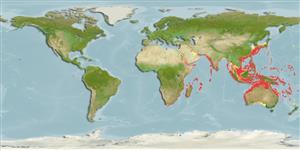Common names from other countries
>
Scombriformes (Mackerels) >
Gempylidae (Snake mackerels)
Etymology: Thyrsitoides: Greek, thyrsites, -ou = stalk of a plant, an ornament like a pine cone borne by Bacchus + Greek, oides = similar to (Ref. 45335).
More on author: Fowler.
Environment: milieu / climate zone / depth range / distribution range
Ökologie
seewasser benthopelagisch; tiefenbereich 0 - 400 m (Ref. 6181). Deep-water; 39°N - 44°S, 25°E - 134°W (Ref. 6181)
Indo-West Pacific: Red Sea to South Africa and New Caledonia, north to Japan. Recently reported from Tonga (Ref. 53797).
Size / Gewicht / Alter
Maturity: Lm ? range ? - ? cm
Max length : 200 cm TL Männchen/unbestimmt; (Ref. 4408); common length : 100.0 cm SL Männchen/unbestimmt; (Ref. 9784)
Rückenflossenstacheln (insgesamt): 17 - 19; Rückenflossenweichstrahlen (insgesamt): 16-17; Afterflossenstacheln 1; Afterflossenweichstrahlen: 16 - 17; Wirbelzahl: 34. Two lateral lines, originating above the upper angle of gill opening, branching below the 4th dorsal-fin spine or slightly behind it, upper line running along the first dorsal-fin base and ending below about the end of the first dorsal fin, lower line abruptly curved backward from bifurcation, running mid laterally to the base of the middle caudal-fin ray. Body color is dark brown with slightly metallic reflections, sometimes slightly paler on belly. Dorsal fin membranes with black markings.
Mesobenthopelagic, down to depths of 400 m or more, often at the surface at night around Okinawa, Japan (Ref. 6181). The largest populations are probably on the slope of seamounts or ridges (Ref. 6181). Feeds on a variety of mesopelagic fish, squid and crustaceans (Ref. 6181).
Life cycle and mating behavior
Geschlechtsreife | Fortpflanzung | Ablaichen | Eier | Fecundity | Larven
Nakamura, I. and N.V. Parin, 1993. FAO Species Catalogue. Vol. 15. Snake mackerels and cutlassfishes of the world (families Gempylidae and Trichiuridae). An annotated and illustrated catalogue of the snake mackerels, snoeks, escolars, gemfishes, sackfishes, domine, oilfish, cutlassfishes,. scabbardfishes, hairtails, and frostfishes known to date. FAO Fish. Synop. 125(15):136 p. (Ref. 6181)
IUCN Rote Liste Status (Ref. 130435)
CITES (Ref. 128078)
Not Evaluated
Bedrohung für Menschen
Harmless
Nutzung durch Menschen
Fischereien: weniger kommerziell
Mehr Information
NamenSynonymeMetabolismusRäuberÖkotoxikologieFortpflanzungGeschlechtsreifeAblaichenFecundityEierEientwicklung
ReferenzenAquakulturAquakultur ProfilZuchtlinienGenetikElectrophoresesVererbbarkeitKrankheitenVerarbeitungMass conversion
Tools
Zusatzinformationen
Download XML
Internet Quellen
Estimates based on models
Preferred temperature (Ref.
115969): 15.3 - 28, mean 23.7 (based on 1045 cells).
Phylogenetic diversity index (Ref.
82804): PD
50 = 1.0000 [Uniqueness, from 0.5 = low to 2.0 = high].
Bayesian length-weight: a=0.00427 (0.00204 - 0.00890), b=3.15 (2.96 - 3.34), in cm Total Length, based on LWR estimates for this species & (Sub)family-body (Ref.
93245).
Trophic level (Ref.
69278): 4.2 ±0.58 se; based on food items.
Widerstandsfähigkeit (Ref.
120179): sehr niedrig, Verdopplung der Population dauert mehr als 14 Jahre. (Preliminary K or Fecundity.).
Fishing Vulnerability (Ref.
59153): Very high vulnerability (90 of 100).
